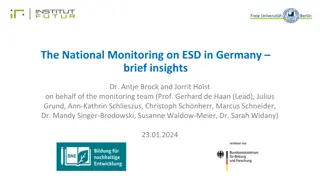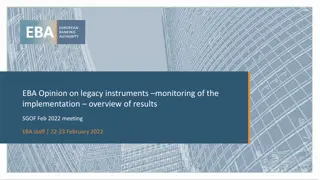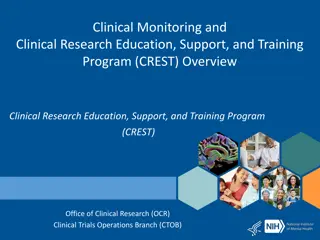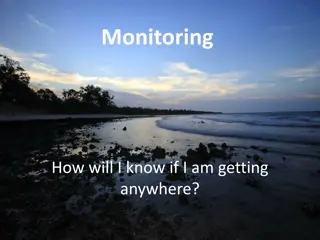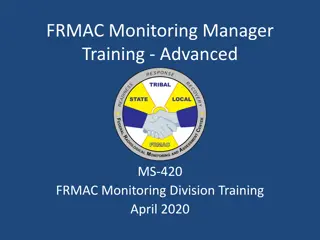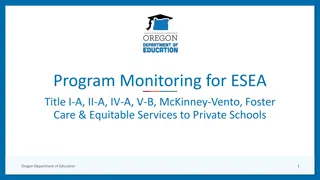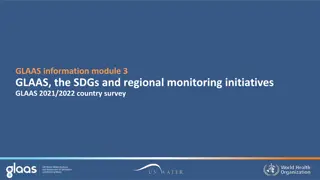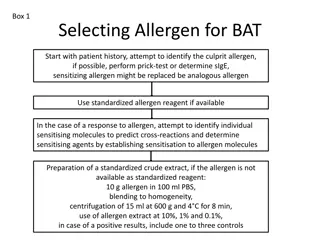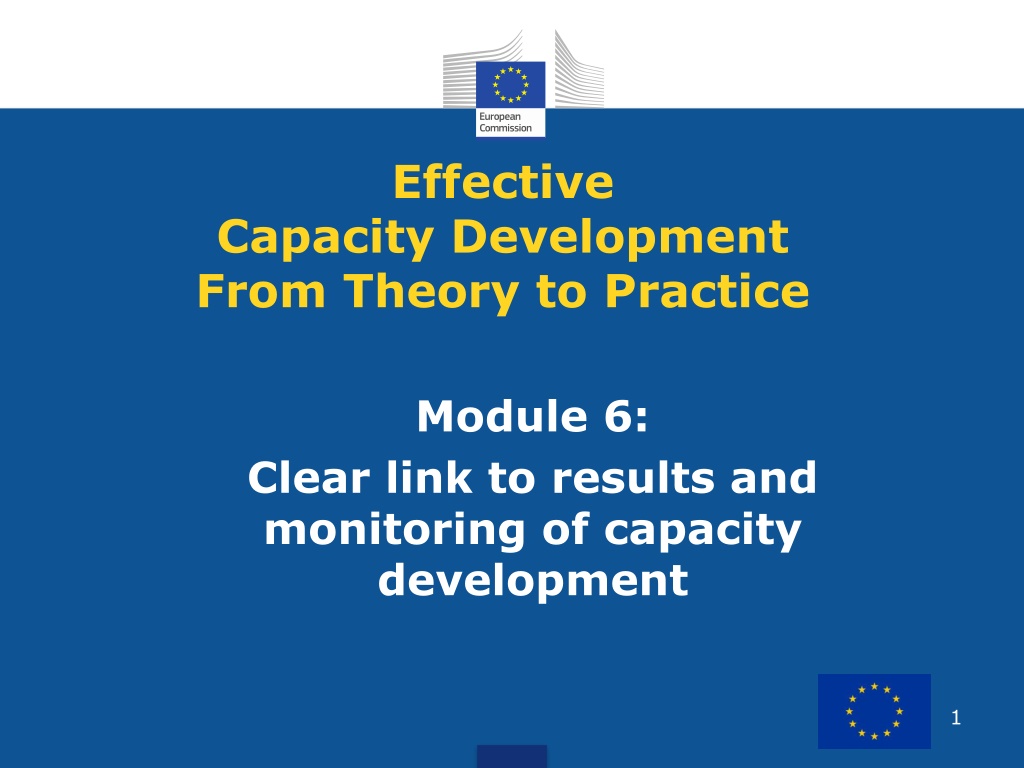
Effective Capacity Development: Linking Results and Monitoring
Learn how to define capacity results and monitor progress effectively in capacity development initiatives. Understand the importance of capturing capacity outcomes and consider contextual factors for successful implementation.
Download Presentation

Please find below an Image/Link to download the presentation.
The content on the website is provided AS IS for your information and personal use only. It may not be sold, licensed, or shared on other websites without obtaining consent from the author. Download presentation by click this link. If you encounter any issues during the download, it is possible that the publisher has removed the file from their server.
E N D
Presentation Transcript
Effective Capacity Development From Theory to Practice Module 6: Clear link to results and monitoring of capacity development 1
This module discusses How to define capacity results How to monitor capacity results
CD Quality grid requirement: 3. Clear link to results and expected outcomes 3.1 Are results and/or outcomes defined beyond what the TC will deliver? Please give examples of key targeted results at the level of enhanced capacity of organisation(s), if relevant outputs that the organisation(s) produce or at the level of outcomes. 3.2 Have the country partners' inputs, which are required to sustain the results of the programme, been identified and specified? 3.3 What innovative forms of TC support have been considered, e.g. regional sources, staff exchanges or networking?
Why Is this Criteria Important? Thinking about results is at the heart of good design and management Capacity results are as important as other development results but easily lost in the results chain How to capture Capacity Results? Think in terms of the outputs (enhanced or modified) of the organization/system arising from CD process Think beyond what external support will achieve since has only limited bearing on outcome
Contextual factors beyond influence Capacity Recurrent inputs Wider impact Outputs Outcomes Internal resources CD processes Contextual factors and actors within influence
PARTNER ORGANISATION/ SECTOR CD PROCESS IMPACT EG: Improved development result eg: better health CD DEVELOPMENT OBJ (IMPACT) Increased use of services OUTCOME EG: Use of products and services by clients/ public CD IMMEDIATE OBJ (OUTCOME) Performance improved OUTPUTS EG: products and services CD OUTPUTS CAPACITY Capacity: Knowledge, systems, rules, behaviour EG: PFM, leadership, logistics, technical CD ACTIVITIES Courses, mentorship, advise INPUTS EG: Budget & Staff CD INPUTS TA, funds, training
Some Challenges Easy to fall into trap of focusing on donor inputs and outputs, not organisation/ sector outputs Difficulty to specify the performance and capacity changes that are sought, and to propose indicators Theory of change often un-developed/ incomplete. Assumption of simple linear causality, and underestimation of impact of different factors on results. Pressure to deliver tangible products, less on facilitating processes, and building sustainable capacity for tomorrow
Specifying CD Results Link changes in capacity to proposed changes in performance Performance = Performance change in organisational/ sector outputs (products and services) Capacity =Enhanced or changed organisational / sector capacity Aim at a realistic balance between: improvements in capacity that can be achieved over the short to medium term and the level of performance that can be expected to accrue. Ideally reflected in a corporate/ sector development plan
Look for results beyond TC deliverables Results focus of CD strategy Results focus of corporate or sector plan Capacity Recurrent inputs Wider impact Outputs Outcomes Internal resour- ces CD processes CD support
Message 1 Be realistic about what can be achieved: Developing capacity is in most cases harder to achieve and support than envisaged CD and support processes take longer time than envisaged CD support only effective when aligned to partner s reform process Think carefully about the change process required to achieve desired results; is it simple, complicated, complex (next module)
Message 2 Avoid over-specifying results given complexity/uncertainty of many CD processes Need to be able to bargain and re-strategise along the way . Changing needs arise from lag between design & implementation Imperfect knowledge when enter the process Be clear on what you want to achieve, leave space to determine how you get there (programme estimates?)
Guiding questions for formulating capacity results Who or what (organisation, target group, sector, etc.) needs capacity? Why is the capacity needed for what purpose? What type of capacity is needed in order to achieve the purpose? Context and Capacity Assessment (QC1) = key sources of information in formulating capacity results Quality of dialogue and level of ownership (QC2) and change readiness will influence what can be realistically achieved 12
Remember. This is not about specifying outputs of external assistance The results chain firmly belongs to the host sector/ agency The role of external assistance comes later
Exercise: Make the partner country CD results chain (what are the changes in capacity aimed for): CD outcome CD output(s) Organisational/Sector Capacity results CD process results CD inputs
Part 2: Monitoring Capacity Processes and Results Monitoring focuses primarily on the processes, organisation and outputs of capacity development Evaluation pays more attention on the CD results produced and their effect on outcomes and impact M&E framework is the flip side of the results framework and should be developed AT THE SAME TIME ESSENTIAL: M&E is the basis for lessons learning and the justification for changing project structure.
M and E Organisational/ Sector Capacity Recurrent inputs Wider impact Outputs Outcomes Internal resour- ces Primary focus of monitoring Primary focus of evaluation CD processes CD support
Monitoring Changes in Capacity Purpose is to track changes in capacity over time both for learning and accountability Can be done by looking at: changes in organisational/ sector outputs and changes in organisational/ sector capacity
Changes in Organisational/ Sector Outputs Results focus of CD strategy Results focus of corporate or sector plan Capacity Recurrent inputs Wider impact Outcomes Outputs Internal resour- ces CD processes TC support
Changes in organisational/ sector outputs Delivery of products and services as foreseen in results framework A helpful proxy indicator but; Capacity does not translate into performance immediately Outputs can improve for reasons other than capacity enhancement Indicators include: producer data: services, products, regulations client / customer satisfaction
Changes in Organisational/ Sector Capacity Results focus of CD strategy Results focus of corporate or sector plan Capacity Recurrent inputs Wider impact Outputs Outcomes Internal resour- ces CD processes TC support
Changes in organisational/ sector capacity can be monitored in many ways: Conduct periodic (self) assessments against a baseline Conduct Assessments that are Peer-based or benchmarked against recognised standards Indicators need to be jointly selected and understood, not imposed Both quantitative and qualitative indicators required to capture both tangible and intangible elements of capacity Consider use of innovative methodologies such as MSC, outcome mapping, and appreciative enquiry
Monitoring the Quality of the Change Process Results focus of CD strategy Results focus of corporate or sector plan Capacity Recurrent inputs Wider impact Outputs Outcomes Internal resour- ces CD processes CD support
Monitoring the Change Process Success depends on joint effort so mutual performance monitoring is important What the country partner has done in terms of leading the process What the external partner has done in terms of supporting the process Can be applied at program level but also at level of individual expert, action Need to also take account of changing contextual/ PEA factors during review Arrange as periodic performance dialogue using a structured format Use of QC in EAMR and ROM
Examples of lead questions How has the context changed during the course of implementation? (Risks and Assumptions) Have enabling and constraining factors increased/ decreased? Has the program responded to a changing context? Have the right processes been used to achieve the desired changes in capacity? Is the external assistance appropriate and performing? Is the partner change management appropriate and effective? Are results being achieved in terms of enhanced capacity and performance? What evidence is there of improved capacity and performance ? What is aggregate effect of strengthening different components of capacity on overall capabilities? Has adequate time elapsed to confirm that change is occurring? What factors beyond program interventions are influencing results?
Who Does What - Monitoring roles Who does what? The partner The EC Monitoring of: Inputs & processes ... periodic, systematic dialogue about mutual performance with TC personnel ...together with partner; periodic dialogue about summary of performance assessment; brokering of conflicts, adjustments of timeframes Outputs & outcomes ...has main responsibility; can be government but also CS watchdogs, parliament etc. Serves learning, management and domestic accountability ...help ensure that results are monitored appropriately; that results of CD monitoring are fed back in adjustments to CD programmes or operations Outcomes & impact ...has prime responsibility; government but also think-tanks, advocacy groups, universities; serves learning and domestic accountability ...mainly to monitor the monitoring by the partner with focus on the capacity of the domestic monitoring system (and support it) 25
Exercise: Formulate CD indicators based on the results chain developed earlier



